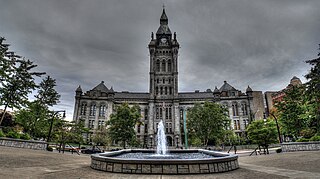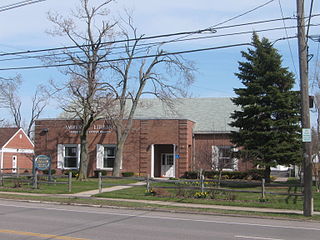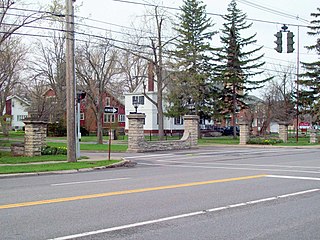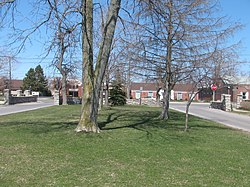
Erie County is a county along the shore of Lake Erie in western New York State. As of the 2020 census, the population was 954,236. The county seat is Buffalo, which makes up about 28% of the county's population. Both the county and Lake Erie were named for the regional Iroquoian language-speaking Erie tribe of Native Americans, who lived in the area before 1654. They were later pushed out by the more powerful Iroquoian nations tribes.

Amherst is a town in Erie County, New York, United States. It is a suburb of Buffalo. As of 2020, the town had a total population of 129,595. This represents an increase from 122,366 as reported in the 2010 census. It is the 14th most populated City/Town in New York.

Clarence is a town and affluent suburb located in the northeastern part of Erie County, New York, United States, northeast of Buffalo. The population was 32,950 according to the 2020 census estimate. This represents an increase of 7.4% from the 2010 census figure. The Clarence census-designated place occupies the southeast part of the town and roughly corresponds to a postal district with ZIP code 14031 and 14221 in the western side which it shares with nearby Williamsville. The town is named in honor of Prince William, Duke of Clarence and St Andrews (1765–1837), the third son of King George III and later king himself, as William IV.

Williamsville is a village in Erie County, New York, United States. The population was 5,423 at the 2020 census. The village is named after Jonas Williams, an early settler. It is part of the Buffalo-Niagara Falls metropolitan area.

Cheektowaga is a town in Erie County, New York, United States. As of the 2020 census, the town has grown to a population of 89,877. The town is in the north-central part of the county, and is an inner ring suburb of Buffalo. The town is the second-largest suburb of Buffalo, after the Town of Amherst.

University is a Buffalo Metro Rail station located near the intersection of Main Street and Niagara Falls Boulevard on the University at Buffalo South Campus. It is a major transfer point between Metro Rail and many city and suburban bus routes and offers a unique "Kiss and Ride" facility on the top level, above the mezzanine. This allows drivers of automobiles a separate area to drop off passengers, so they do not add to the traffic congestion from buses at the station during rush-hour periods and a large park-and-ride facility directly to the east of the station. Since University station serves as a terminal, immediately south is a double crossover. From May 20, 1985, to November 10, 1986, due to construction issues at LaSalle station, Amherst Street station served as the northern terminus. Since November 10, 1986, university station has served as the northern terminus.

East Amherst is a suburban hamlet 16 miles (26 km) northeast of downtown Buffalo, Erie County, New York, United States. It straddles the towns of Amherst and Clarence, and comprises the majority of ZIP code 14051.
Amherst State Park is an 80-acre (0.32 km2) park in Erie County, New York, United States. The park is located northeast of Buffalo, partially in the Village of Williamsville with the balance located in the Town of Amherst. The park is managed by the Town of Amherst under an agreement with the New York State Office of Parks, Recreation and Historic Preservation.

Williamsville South High School is a high school located in Williamsville, New York, a suburb of Buffalo, New York. South is one of three high schools in the Williamsville Central School District, along with Williamsville North High School and Williamsville East High School.

Snyder is a hamlet within the town of Amherst in Erie County, New York, that is part of the Buffalo–Niagara Falls metropolitan area. The hamlet was established in 1837. It was named for Michael Snyder, its first postmaster, who also operated a store at the corner of Harlem Road, which is also known as New York State Route 240, and Main Street, which is also known as New York State Route 5. The hamlet blossomed due to retail activity demand created along the Main Street transportation route between Buffalo and points to the east in the 19th and early 20th century.

The Buffalo & Erie County Public Library is located on Lafayette Square, Buffalo, New York. The current facility, designed by Kideney Architects and built in 1964, replaced the original Cyrus Eidlitz Buffalo Public Library Building dedicated in February 1887. The first Buffalo Public Library, in turn, replaced the Erie County, New York courthouse, which occupied the parcel from 1816-1876.

Getzville is a hamlet in the town of Amherst in Erie County, New York, United States. Getzville's ZIP code is 14068, and its post office is located on Millersport Highway.

The Southtowns is a region of Western New York, United States, that lies within the snowbelt or ski country. It includes the southern suburbs of Buffalo, New York. This is the common name for the southern part of Erie County, New York.

Entranceways at Main Street at Lamarck Drive and Smallwood Drive are a set of complementary residential subdivision stone entranceways built in 1926. They are located on Main Street in the hamlet of Snyder, New York within the town of Amherst, which is located in Erie County. These entranceways are markers representing the American suburbanization of rural areas through land development associated with transportation on the edges of urban developments. The Smallwood entranceway is a pair of symmetric groupings of stone gatehouses and posts flanking the two sides of the drive at Main Street. The Lamarck entranceway is a pair of Y-shaped and U-shaped stone half-walls flanking the two sides of the drive at Main Street. The entranceways were added to the National Register of Historic Places on December 7, 2005.

Eggertsville is a hamlet and census-designated place (CDP) within the town of Amherst in Erie County, New York, United States. The population of the CDP was 15,019 at the 2010 census.

Entranceway at Main Street at Darwin Drive is a suburban residential subdivision entranceway and street furniture built about 1927 by developer Charles S. Burkhardt. It is located on Main Street in the town of Amherst within Erie County. It consists of two matching sets of stone sculptures set on either side of the drive. It also includes the painted metal street sign post.

Entranceway at Main Street at High Park Boulevard is a suburban residential subdivision entranceway built about 1916 by developer Charles S. Burkhardt. It is located on Main Street at Eggertsville in the town of Amherst within Erie County. It consists of tall and short stone posts, corresponding quarter-height stone walls, and accent light fixtures set on either side of the streets' intersecting corners.

Entranceway at Main Street at Lafayette Boulevard is a suburban residential subdivision entranceway built about 1920 by Orange & Black Corp., Developers. It is located on Main Street in the town of Amherst within Erie County. It consists of roofed stone archways, connecting half-height stone walls, and stone posts located on either corner.

Entranceway at Main Street at LeBrun Road is a suburban residential subdivision entranceway in Amherst, New York, USA. It was built about 1920 by Goode & Sickels, Realtors. It is located on Main Street at Eggertsville in the town of Amherst within Erie County. It consists of half-height brick masonry walls, brick masonry posts, and accent light fixtures located on either street corner.

Entranceway at Main Street at Westfield Road and Ivyhurst Road is a suburban residential subdivision entranceway built about 1920 by John Sattler. It is located on Main Street in the town of Amherst within Erie County. It consists of stone posts, connecting quarter-height stone walls, and accent light fixtures located on either street corner.


























